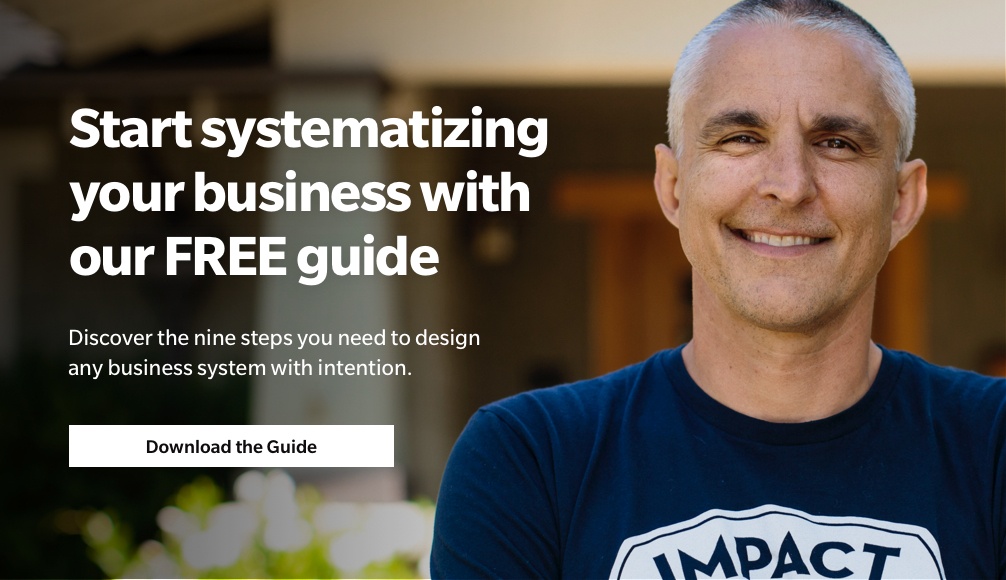A strong Leadership System is foundational to any business, but understanding leadership as a system (rather than merely certain competencies) is foreign to many entrepreneurs. Instead, business owners tend to focus on developing leadership skills—communication, team development, strategic thinking—which are undeniably important, but not the backbone of the organizational structure. Just as with the other essential systems in your business, you have to develop and consistently iterate on the core components of your Leadership System to create a vision for your business—and to keep that vision alive as you and your people work towards realizing it.
So, what is a Leadership System? Here’s how we approach leadership at EMyth, and the processes that go into building this element of your business.
The definition of a Leadership System
Everything in your business ultimately rises or falls on your leadership. This is clear to many business owners who landed in the leadership hot seat and quickly realized, “I don’t know how to lead.” What’s not so clear is what leadership actually is. Yes, there are many characteristics of being a great leader, but great leadership is about defining a vision and guiding people to achieve it. And it’s very systematic. To produce consistent and predictable results that lead to successfully meeting key objectives, your business relies on three things: your vision, your values and a Brand Promise. These elements are at the heart of your Leadership System and inform every other system in your business.
What is takes to be an entrepreneurial leader
These processes make up your Leadership Systems. And while some are touchstones that may rarely (or never) change, others may require consistent diligence, upkeep or revision.
Manage your time
As a business owner, time is your most precious resource. More than any other habit, using time wisely will increase your productivity and effectiveness as a leader. Here are some tools to help discover how you use your time, recognize and eliminate inefficient practices and distractions, and prioritize important strategic work.
Create your Primary Aim
Your Primary Aim is that innermost driving force—the source of your vitality, vision and commitment—that motivates you and gives you the energy of purpose. It’s rooted in what you want from your life, grounding your leadership and decision-making in your business with a solid understanding of what is and isn’t important to you.
Write your company values
Everything in your business is connected to your company values. From the way you lead your people, to your Marketing Strategy or product fulfillment, your values live in all aspects of your organization. And no one is going to do the work of defining those except for you. In the EMyth Program, we first identify your personal core values—the ones you stand for more than anything else. When you want one of your personal values to show up in the way you do business, it becomes a core company value. So, start by creating your personal list and see which translate directly into company values. Not all will, but some must—or you’re not creating a company that truly reflects you.
Identify your Brand Promise
Whether you recognize it or not, your business does have a brand that’s been established by your customers, your competition and proactively by you. So be proactive! Don’t let your brand be developed passively by the outside factors because you skipped this process. Create a Brand Promise statement that describes what you want your customers to feel in every interaction with your business. In it, describe one thing that you can promise to deliver—above and beyond everything else—that differentiates your business from your competitors. It’s your proprietary way we do it here.
Define your strategic objective
As Stephen Covey said, “Begin with the end in mind.” Your strategic objective describes how you want your business to look at a certain point—three years, for example—in the future. It should be a clear and vivid picture of how your business will look, act, feel and perform at that time. It’s the critical visionary piece that you and your team need to work back from, step by step.
Develop a system of Key Strategic Indicators (KSIs)
Once you have your strategic objective in place, Key Strategic Indicators measure your progress toward it, ideally in one easy-to-read report. You’ll need to identify tangible indicators that can be measured objectively, such as financial numbers and growth percentages. You’ll also need intangible indicators that subjectively measure important aspects of your business such as employee engagement, systemization or customer satisfaction.
Get to the root of your key frustrations
What’s frustrating you most in your business today? No meaningful cash flow? Unable to attract and hire the right people? Whatever your frustrations are, they indicate a broken (or missing) system that brings the same negative results again and again. To alleviate your frustrations, you first need to recognize that they’re the result of chronic problems in your business, and very often the underlying cause isn’t what you think.
An exercise to take a deeper look at your key frustrations can teach you how to step back from your immediate reactions to see the underlying causes of your frustrations. It also helps you shift your focus away from blaming people (including yourself), and create a system solution instead.
Your foundational Leadership System doesn’t simply guide your company—it gives you the confidence and structure to lead. Reach out if you’d like to talk about how to start developing this system in your business.




Comments